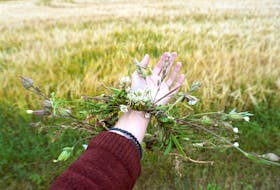SOUTH WEST NOVA SCOTIA - An ecological risk evaluator collecting water samples for Environment and Climate Change Canada had a bird’s-eye view of the region in late October.
Benoit Lalonde’s work takes him through Nova Scotia from Yarmouth to Chéticamp at least every two months.
This fall, he sampled about 60 lakes in New Brunswick and Nova Scotia, including many in Yarmouth and Digby counties.
The water samples are collected via a helicopter on floats. They’re analyzed for nutrients (phosphorus, nitrogen, nitrate), turbidity, conductivity, pH, ions (magnesium, potassium, calcium etc), alkalinity, total organic carbon and metals.
The objective of the project is to study the impacts of atmospheric pollution on aquatic ecosystems.
When the project began in 1983, it was meant to study acid rain issues, but it now looks at impacts from climate change and mercury on aquatic ecosystems.
The sampling of lakes in this province and New Brunswick is meant to evaluate a joint Canadian-U.S. program that is seeking to reduce the emissions of acid rain-causing chemicals such as sulfur dioxides and nitrogen oxides.
Lalonde says the program seems to be working since there is a reduction in sulfates (indicator of sulfur dioxide) and in the acidity of the lakes in the network.
The lakes in the sampling program are located in Nova Scotia, New Brunswick, Newfoundland and Labrador, Quebec, Ontario and near the oil sand deposits of Alberta.
The project is also part of an international sampling program with lakes located in Scandinavia, U.S., France, Italy, Germany and Poland.
“The sampling of the lakes also serves a purpose which is to calculate a critical load of atmospheric pollutants a lake can receive before its level of acidity increases,” said Lalonde.
“Lastly, the project is ongoing in the near future and we are starting to notice certain trends in the chemistry of lakes which are probably caused by climate change such as an increase in organic carbon.”
Lalonde says he’s lucky that his work coincides with his passion: waterfalls. He’s written a guide on them that was published in May.

Lakes sampled
Water samples were obtained from the following lakes: Brenton, George, Killams, Cedar, Cornings, Snare, Tedford, Pecee, Bird, Trefry, Poplar, Liberty, Pebbleloggitch and Beaverskin (the last four are just west of Kejimkujik).
For more information specific to the lake sampling performed this October, visit this link.







